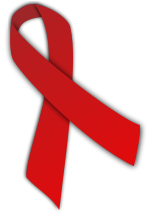BY OLUWASEUN
Abj Loving, Abuja Living: When I got this article a few days back, I felt it was perfect for today, it's the world AIDS day. December 1st of every year has been set aside since 1988 as a day to raise awareness for the chaos AIDS has cursed. The fight to kick out HIV/AIDS starts with you protecting yourself.
In Nigeria, the HIV prevalence rate among adults ages 15–49 is 3.9 percent. Nigeria has the third-largest number of people living with HIV. The HIV epidemic in Nigeria is complex and varies widely by region. In some states, the epidemic is more concentrated and driven by high-risk behaviors, while other states have more generalized epidemics that are sustained primarily by multiple sexual partnerships in the general population. Youth and young adults in Nigeria are particularly vulnerable to HIV, with young women at higher risk than young men. There are many risk factors that contribute to the spread of HIV, including prostitution, high-risk practices among itinerant workers, high prevalence of sexually transmitted infections (STI), clandestine high-risk heterosexual and homosexual practices, international trafficking of women, and irregular blood screening.
The size of the population and the nation pose logistical and political challenges particularly due to the political determination of the Nigerian Government to achieve health care equity across geopolitical zones. The necessity to coordinate programs simultaneously at the federal, state and local levels introduces complexity into planning. The large private sector is largely unregulated and, more importantly, has no formal connection to the public health system where most HIV interventions are delivered. Training and human resource development is severely limited in all sectors and will hamper program implementation at all levels. Care and support is limited because existing staff are overstretched and most have insufficient training in key technical areas to provide complete help.
injecting drug users (IDUs), transport workers, members of the Armed Forces and Police. It has been found that individuals that fall under these groups and their partners account for 40 percent of new HIV infections in Nigeria.
The total number of condoms provided by international donors has been relatively low. Between 2000 and 2005, the average number of condoms distributed in Nigeria by donors was 5.9 per man, per year.
Restrictions on condom promotion have hampered HIV prevention efforts. In 2001, a radio advertisement was suspended by the Advertising Practitioners Council of Nigeria (APCON) for promoting messages suggesting that it is acceptable to engage in premarital sex as long as a condom is used. In 2006 APCON also started to enforce stricter regulations on condom advertisements that might encourage ‘indecency’.
The number of female condoms sold in Nigeria has significantly increased from 25,000 in 2003 to 375,000 in 2006.
Support Durex on its Campaign against HIV/AIDS.
Donate a Click...Save a LIFE. Like this page http://qrs.ly/jo2drjb


No comments:
Post a Comment